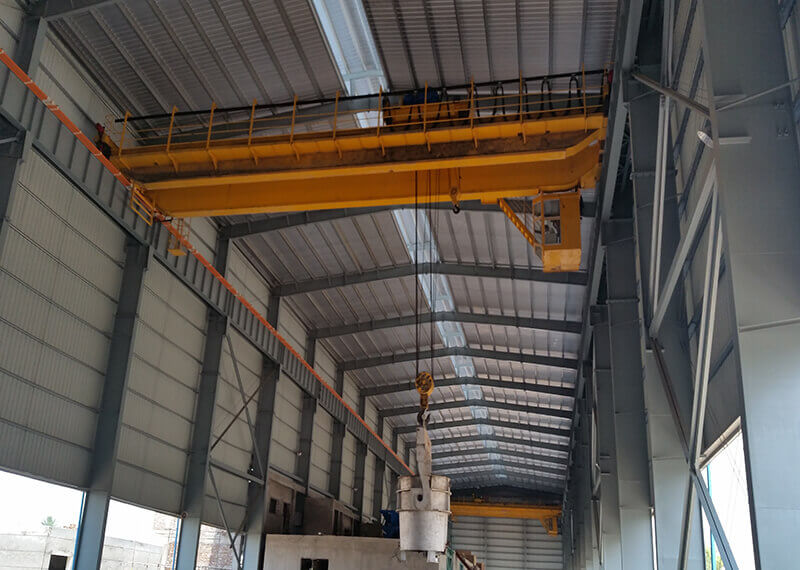
What are the types of bridge cranes?
When you've decided to build a bridge crane, the following step is to figure out which sort of bridge crane is best for your needs. Bridge cranes are available in many different configurations, sizes, forms, and designs. Each type is tailored to meet the requirements of a certain application.
Choosing the right crane might be difficult due to the large number of options available. The correct crane and its specs may significantly boost production and efficiency while also streamlining operations.
Bridge Crane –A bridge crane has two runways built into and attached to the superstructure on either side of the building. End trucks that run on wheels on the runway connect the runways with a bridge. The bridge can be set up as a single or double bridge, with a trolley on each side. The trolley and hoist run along the bottom of the bridge, underhung.
Gantry Crane –With one exception, a gantry crane is quite similar to a bridge crane. The runways of a bridge crane are attached to the building's superstructure. A gantry crane is supported and moved by four legs. The legs are attached to the bridge, trolley, and hoist. To position the bridge for loading, lifting, and moving, the legs move along rails. Like a railway track, the leg rails are installed on the floor, ground, or foundation.
Monorail Crane –Monorail cranes, unlike gantry and bridge cranes, do not have a bridge or girders. The trolley is attached to a ceiling-mounted I beam and runs down the flat surface at the bottom of the beam. The material is carried by the hoist and pushed by the trolley in a straight line along the beam. The flexibility of a monorail bridge crane to have curves, branches, and switches to change height and direction is one of its most valuable features.
Jib Crane –A jib crane is a type of bridge crane that does not require the use of a bridge, runway, or any other type of track system. They can be mounted and put in a variety of ways, from being attached to a wall to standing alone. Jib cranes are space-saving, cost-effective, and ideal for moving large components. They can be designed to revolve in a full circle or have a limited rotation range. Even small jib cranes can lift and transfer many tons.
Top and Bottom Running Crane –The location of the wheels on the bridge girders determines whether the crane is top or bottom running. The bridge runs along the top of the runway beams, with top-running cranes. The beam bridge is supported on the bottom of the runway beams in the event of bottom running, or underhung cranes. The crane wheels travel along the girders' lowest flange.
Top-running cranes have a greater lifting capability and can raise bigger loads. Underhung cranes are often used for lighter loads and have a smaller capacity because they are supported by roof or ceiling supports.
Automated Crane –The control of a bridge crane can be fully automated, in which the operator programs the crane's actions and it completes each task without human intervention, or semi-automated, in which the operator controls specific functions. The type of software programmed into the crane is crucial to a completely automated system. This type of technology is appropriate for demanding and hazardous environments where the operator may be harmed. Another advantage of an automated system is that it frees the operator from the boredom of repetitive movements.
By removing the human, automated systems produce fewer errors or blunders and finish processes quickly and flawlessly. Lifting, placing, stacking, and storing are examples of duty cycles that can be repeated several times during a period of time ranging from eight to twenty-four hours.
Workstation Crane –Workstation cranes are a type of bridge crane that can handle light to big loads. They can lift up to two tons and are available in a variety of configurations to match any area. Workstation cranes are smaller and more compact than bigger cranes, allowing them to be readily put beneath jib or other types of bridge cranes to provide a more efficient work cell.
The ergonomics of workstation cranes are crucial, as they eliminate the need to lift big products or items. Workstation cranes boost worker morale, quality, productivity, and safety, among other things.
Grab bridge cranes –A grab bridge crane might have a bridge, gantry, or folding arm design. It comes with a bucket, an orange peel, and a clam shell. This crane has a single or double girder design and is used to handle bulk goods. Grab cranes are used to load logs, minerals, coal, sand, and gravel at mines, ports, and station yards.


